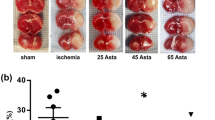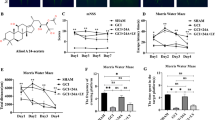Abstract
Neurotransmitter imbalance is an inevitable outcome in cerebral ischemia that leads to neuronal death. In the present study, we evaluated the effects of piroxicam, a nonsteroidal anti-inflammatory drug (NSAID), on extracellular brain glutamate and γ-aminobutyric acid (GABA) release, survival time, and neuronal cell death. Transient focal cerebral ischemia in male Charles Foster rat led to neuronal infarction and compromised intrinsic antioxidant status. Thirty-minute preadministration of piroxicam (10 mg/kg b.w.) showed a significant (P < 0.01) reduction in cerebral infarct volume and potentiation of the intrinsic antioxidant status. High-performance liquid chromatography of brain cortex and striatum revealed changes in extracellular concentrations of neurotransmitters which were found to be 0.519 ± 0.44 pmole/mg (GABA); 1.18 ± 0.28 pmole/mg (glutamate), and 0.63 ± 0.21 pmole/mg (serotonin), respectively. Hydroxyl radical (·OH) adduct of salicylate in the frontal cortex and striatum in control, untreated, and treated groups was found to be 0.261 ± 0.06, 0.68 ± 0.52, and 0.401 ± 0.68 pmole/mg, respectively. After stroke, the extracellular level of glutamate in rat brain increases continuously as compared to that of control group. However, piroxicam administration in stroke rat significantly reduced (P < 0.05) elevated extracellular cerebral glutamate. This indicates that piroxicam attenuates extracellular glutamate release and also reduces neuronal cell death due to reduction in oxidative stress in cerebral ischemia. Our results also indicate a consequent increase of extracellular GABA in brain regions administered with piroxicam, which hints that piroxicam alleviates glutamate excitotoxicity possibly by GABA agonism.








Similar content being viewed by others

Change history
08 September 2020
Editor's Note: Concerns have been raised about the integrity of the data reported in this article (Bhattacharya et al., 2014). This is currently being investigated. Further editorial action may be taken as appropriate once the investigation into the concerns is complete and all parties have been given an opportunity to respond in full.
05 April 2022
This article has been retracted. Please see the Retraction Notice for more detail: https://doi.org/10.1007/s13105-022-00889-2
Abbreviations
- GABA:
-
γ-Aminobutyric acid
- Glu:
-
Glutamate
- 2,3-DHBA:
-
2,3-Dihydroxy benzoic acid
- 2,5-DHBA:
-
2,5-Dihydroxy benzoic acid
- NSAID:
-
Nonsteroidal anti-inflammatory drug
- SA:
-
Salicylic acid
References
Aebi H (1984) Catalase in vitro. Methods Enzymol 105:121–126
Allen NJ, Rossi DJ, Attwell D (2004) Sequential release of GABA by exocytosis and reversed uptake leads to neuronal swelling in simulated ischemia of hippocampal slices. J Neurosci 24:3837–3849
Arundine M, Tymianski M (2004) Molecular mechanisms of glutamate dependent neurodegeneration in ischemia and traumatic brain injury. Cell Mol Life Sci 61:657–668
Bhattacharya P, Pandey AK, Paul S, Patnaik R (2012) Cognitive effects of NSAIDs in cerebral ischemia: a hypothesis exploring mechanical action mediated pharmacotherapy. Med Hypotheses 79(1):393–395
Bhattacharya P, Pandey AK, Paul S, Patnaik R (2012) Combination therapy of Ifenprodil with Piroxicam may be an effective therapeutic intervention in cerebral stroke: a hypothesis. Med Hypotheses 79(1):516–518
Bhattacharya P, Pandey AK, Paul S, Patnaik R (2012) Neuroprotective potential of Piroxicam in cerebral ischemia: an in-silico evaluation of the hypothesis to explore its therapeutic efficacy by inhibition of aquaporin-4 and acid sensing ion channel 1a. Med Hypotheses 79(12):352–357
Bhattacharya P, Pandey AK, Shukla S, Paul S, Patnaik R (2013) Neuroprotection by μ-calpain and matrix metalloproteinases inhibition by Piroxicam in cerebral ischemia: an in silico study. Med Chem Res 22(11):5112–5119
Bhattacharya P, Pandey AK, Paul S, Patnaik R, Yavagal D (2013) Aquaporin-4 inhibition mediates Piroxicam-induced neuroprotection against focal cerebral ischemia/reperfusion injury in rodents. PLoS One 8(9):e73481.1371
Shankaranarayana Rao BS, Raju TR, Meti BL (1998) Self-stimulation of lateral hypothalamus and ventral tegmentum increases the levels of noradrenaline, dopamine, glutamate, and AChE activity, but not 5- Hydroxytryptamine and GABA levels in hippocampus and motor cortex. Neurochem Res 23(8):1053–1059
Butcher SP, Bullock R, Graham DI, McCulloch J (1990) Correlation between amino acid release and neuropathologic outcome in rat brain following middle cerebral artery occlusion. Stroke 21:1727–1733
Chance B, Sies H, Boveris A (1979) Hydroperoxide metabolism in mammalian organs. Physiol Rev 59:527–535
Chiueh CC, Miyake H, Peng MT (1993) Role of dopamine autoxidation, hydroxyl radical generation, and calcium overload in underlying mechanisms involved in MPTP-induced parkinsonism. Adv Neurol 60:251–258
Costa C, Leone G, Saulle E, Pisani F, Bernardi G, Calabresi P (2004) Coactivation of GABA(A) and GABA(B) receptor results in neuroprotection during in vitro ischemia. Stroke 35:596–600
Coyne L, Jiping S, Patten D, Halliwell RF (2007) Characterization of the interaction between fenamates and hippocampal neuron GABAA receptors. Neurochem Int 51(6–7):440–446
Deng P, Zhang Y, Xu ZC (2008) Inhibition of Ih in striatal cholinergic interneurons early after transient forebrain ischemia. J Cereb Blood Flow Metab 28:939–947
Djuricic B (2002) Glutamate in brain: transmitter and poison. Glas Srp Akad Nauka 47:55–76
Dirnagl U, Iadecola C, Moskowitz MA (1999) Pathobiology of ischaemic stroke: an integrated view. Trends Neurosci 22(9):391–397
Fujimoto S, Katsuki H, Kume T, Kaneko S, Akaike A (2004) Mechanisms of oxygen glucose deprivation induced glutamate release from cerebrocortical slice cultures. Neurosci Res 50:179–187
Globus MY, Busto R, Dietrich WD, Martinez E, Valdes I, Ginsberg MD (1988) Effect of ischemia on the in vivo release of striatal dopamine, glutamate, and gamma-aminobutyric acid studied by intracerebral microdialysis. J Neurochem 51:1455–1464
Green AR, Hainsworth AH, Jackson DM (2000) GABA potentiation: a logical pharmacological approach for the treatment of acute ischemic stroke. Neuropharmacol 39:1483–1494
Gelderblom M, Leypoldt F, Steinbach K, Behrens D, Choe CU, Siler DA, Arumugam TV, Orthey E, Gerloff C, Tolosa E, Magnus T (2009) Temporal and spatial dynamics of cerebral immune cell accumulation in stroke. Stroke 40:1849–1857
Halliwel B (1987) Oxidants and human disease: some new concepts. Fed Am Soc Exp Biol 1:358–366
Heiss WD, Grond M, Thiel A, von Stockhausen HM, Rudolf J, Ghaemi M, Löttgen J, Stenzel C, Pawlik G (1998) Tissue at risk of infarction rescued by early reperfusion: a positron emission tomography study in systemic recombinant tissue plasminogen activator thrombolysis of acute stroke. J Cereb Blood Flow Metab 18:1298–1307
Hauss-Wegrzynizk B, Vraniak P, Wenk GL (1999) The effects of a novel NSAID on chronic neuroinflammation are age dependent. Neurobiol Aging 20(3):305–313
Jollow DJ, Mitchell JR, Zampaglione N (1974) Bromobenzene induced liver necrosis. Protective role of glutathione and evidence for 3, 4-bromobenzene oxide as the hepatotoxic metabolite. Pharmacology 11:151–169
Jin R, Yang GJ, Li GH (2010) Inflammatory mechanisms in ischemic stroke: role of inflammatory cells. J Leukoc Biol 87:779–789
Kuramoto N, Wilkins ME, Fairfax BP, Revilla-Sanchez R, Terunuma M, Tamaki K, Iemata M, Warren N, Couve A, Calver A (2007) Phospho-dependent functional modulation of GABA(B) receptors by the metabolic sensor AMP-dependent protein kinase. Neuron 53:233–247
Hong K-S, Saver JL (2009) Quantifying the value of stroke disability outcomes WHO global burden of disease project disability weights for each level of the modified rankin scale. Stroke 40:3828–3833
Lievre V, Bechuwe P, Bianchi A, Bossenmeyer P, Koziel V, Franck VP, Nicolos P, Dauca MBM, Daval JC (2001) Intracellular generation of free radicals and modifications of detoxifying enzymes in cultured neurons from the developing rat forebrain in response to transient hypoxia. Neuroscience 105:287–297
Longa EZ, Weinstein PR, Carlson S, Cummins R (1989) Reversible middle cerebral artery occlusion without craniectomy in rats. Stroke 20:84–91
Louzada PR, Lima AC, Mendonca-Silva DL, Noel F, Mello FG, Ferreira ST (2004) Taurine prevents the neurotoxicity of beta-amyloid and glutamate receptor agonists: activation of GABA receptors and possible implications for Alzheimer’s disease and other neurological disorders. FASEB J 18:511–518
Luo C, Guo LJ (2005) Effect of taurine on acute ischemia-induced neuron apoptosis in rats. Chin Pharmacol Bull 90:1057–1061
Matsumoto N, Kumamoto E, Furue H, Yoshimura M (2003) GABA-mediated inhibition of glutamate release during ischemia in substantia gelatinosa of the adult rat. J Neurophysiol 89:257–264
Mergenthaler P, Dirnagl U, Meisel A (2004) Pathophysiology of stroke: lessons from animal models. Metab Brain Dis 19:151–167
Nakagomi T, Sasaki T, Kirino T, Tamura A, Noguchi M, Saito I, Takakura K (1989) Effect of cyclooxygenase and lipoxygenase inhibitors on delayed neuronal death in the Gerbil Hippocampus. Stroke 20:925–929
Nelson RM, Green AR, Lambert DG, Hainsworth AH (2000) On the regulation of ischaemia-induced glutamate efflux from rat cortex by GABA; in vitro studies with GABA, clomethiazole and pentobarbitone. Br J Pharmacol 130:1124–1130
Ng TK, Yung KK (2001) Differential expression of GABA (B) R1 and GABA (B) R2 receptor immunoreactivity in neurochemically identified neurons of the rat neostriatum. J Comp Neurol 433:458–470
Nishizawa Y (2001) Glutamate release and neuronal damage in ischemia. Life Sci 69:369–381
Oberley LW, Spitz DR (1984) Assay of superoxide dismutase activity in tumor tissue. Methods Enzymol 105:457–464
Ouyang CH, Guo LJ, Lu Q, Qu L (2004) Effect of -aminobutyric acid on amino acids and calcium levels in rat brain of acute incomplete global cerebral ischemia. Chin J Pharmacol Toxicol 18:248–252
Ouyang C, Ouyanga LC, Guoa L, Lua Q, Xua X, Wang H (2007) Enhanced activity of GABA receptors inhibits glutamate release induced by focal cerebral ischemia in rat striatum. Neurosci Lett 420:174–178
Okun E, Griffioen KJ, Lathia JD, Tang SC, Mattson MP, Arumugam TV (2009) Toll-like receptors in neurodegeneration. Brain Res Rev 59:278–292
Pang ZP, Deng P, Ruan YW, Xu ZC (2002) Depression of fast excitatory synaptic transmission in large aspiny neurons of the neostriatum after transient forebrain ischemia. J Neurosc 22:10948–10957
Pende M, Lanza M, Bonanno G, Raiteri M (1993) Release of endogenous glutamic and asparatic acids from cerebrocortex synaptosomes and its modulation through activation of -aminobutyric acidB (GABAB) receptor subtype. Brain Res 604:325–330
Phillis JW, O’Regan MH (2003) Characterization of modes of release of amino acids in the ischemic/reperfused rat cerebral cortex. Neurochem Int 43:461–467
Smith WS (2004) Pathophysiology of focal cerebral ischemia: a therapeutic perspective. J Vasc Int Radiol 15:S3–S12
Swanson RA, Morton MT, Tsao-Wu G, Savalos RA, Davidson C, Sharp FR (1990) A semiautomated method for measuring brain infarct volume. J Cereb Blood Flow Metab 10:290–293
Saver JL, Albers GW, Dunn B, Johnston KC, Fisher M (2009) Stroke Therapy Academic Industry Roundtable (STAIR) recommendations for extended window acute stroke therapy trials. Stroke 40:2594–2600
Tanaka E, Niiyama S, Uematsu K, Yokomizo Y, Higashi H (2002) The presynaptic modulation of glutamate release and the membrane dysfunction induced by in vitro ischemia in rat hippocampal CA1 neurons. Life Sci 72:363–374
Tanaka S, Tsuchida A, Kiuchi Y, Oguchi K, Numazawa S, Yoshida T (2003) GABAergic modulation of hippocampal glutamatergic neurons: an in vivo microdialysis study. Eur J Pharmacol 465:61–67
Thomas GM, Huganir RL (2004) MAPK cascade signalling and synaptic plasticity. Nat Rev Neurosci 5:173–183
Tuttolomondo A, Di Raimondo D, di Sciacca R, Pinto A, Licata G (2008) Inflammatory cytokines in acute ischemic stroke. Curr Pharm Des 14:3574–3589
Vartiainen N, Huang CY, Salminen A, Goldsteins G, Chan PH, Koistinaho J (2001) Piroxicam and NS-398 rescue neurones from hypoxia/reoxygenation damage by a mechanism independent of cyclo-oxygenase inhibition. J Neurochem 76:480–489
Wang Q, Tang XN, Yenari MA (2007) The inflammatory response in stroke. J Neuroimmunol 184:53–68
Zoppo GJ, Milner R, Mabuchi T, Hung S, Wang XY, Berg GI, Koziol JA (2007) Microglial activation and matrix protease generation during focal cerebral ischemia. Stroke 38:646–651
Author information
Authors and Affiliations
Corresponding authors
Additional information
Pallab Bhattacharya and Anand Kumar Pandey have equal contribution
About this article
Cite this article
Bhattacharya, P., Pandey, A.K., Paul, S. et al. RETRACTED ARTICLE: Alleviation of glutamate mediated neuronal insult by piroxicam in rodent model of focal cerebral ischemia: a possible mechanism of GABA agonism. J Physiol Biochem 70, 901–913 (2014). https://doi.org/10.1007/s13105-014-0358-8
Received:
Accepted:
Published:
Issue Date:
DOI: https://doi.org/10.1007/s13105-014-0358-8



